Wireless charging technology will give engineers the freedom to make devices smaller and lighter by eliminating the energy storage devices, such as bulky batteries, in them. The improvement in processing capabilities of our handheld devices makes wireless charging a convenient or rather an essential technology.
Wireless charging, a technology that was demonstrated over a century ago by Nikola Tesla but could not find any practical use for a long time is now becoming ubiquitous in a wide variety of devices, such as smartphones and smartwatches. A considerable amount of research and development is being done to improve the capabilities and even introduce wireless charging in highly power-intensive applications like electric vehicle (EV) charging. Wireless charging is of three types: resonant charging, inductive charging, and RF charging.
Wireless charging is a very hot topic at present; the wireless charging market is expected to experience a growth of 26% CAGR from 2022 to 2027. The growth is reflected in the advancement in technology and the increase in the number of new launches. The latest trends in wireless charging modules are:
- Adoption of Qi 1.3
- Integration of antenna board
- More powerful processors
- Better protection features
- Higher power transfer rate
- Increased interfaces
- Smaller modules for smarter wearables
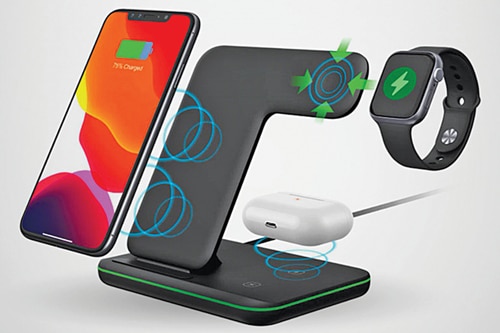
Adoption of Qi 1.3
Qi 1.3 is the latest update from WPC, rolled out in the middle of 2021. This is a major update since the launch of Qi 1.2 in 2015. This standard improves control of the power transfer between the transmitter and receiver and mandates hardware-based authentication for higher security. The Qi 1.3 allows for higher data transfer rates up to 15W. Modules such as Renesas’s P9261and STM’s STWLC98 feature Qi 1.3 standard.
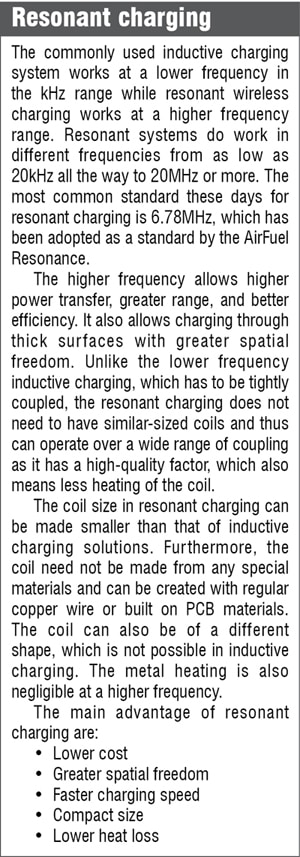 Integration of antenna board
Integration of antenna board
The compact transmitter and receiver modules that utilise resonant charging working at a frequency of 13.56MHz are capable of transmitting both power and data. These modules come with an integrated antenna in a small form factor, thus reducing the size of the product along with the time and cost of development.
 These boards use the same frequency band as the NFC communication standard. These modules mostly support both bi-directional data communication (256B Max. at 212kbps) and NFC Forum Type 3 Tag transmission. The bi-directional data transfer allows for advanced functions, such as firmware download, secure data transfer, and rewriting of sensor, device, or authentication information to battery output voltage values.
These boards use the same frequency band as the NFC communication standard. These modules mostly support both bi-directional data communication (256B Max. at 212kbps) and NFC Forum Type 3 Tag transmission. The bi-directional data transfer allows for advanced functions, such as firmware download, secure data transfer, and rewriting of sensor, device, or authentication information to battery output voltage values.
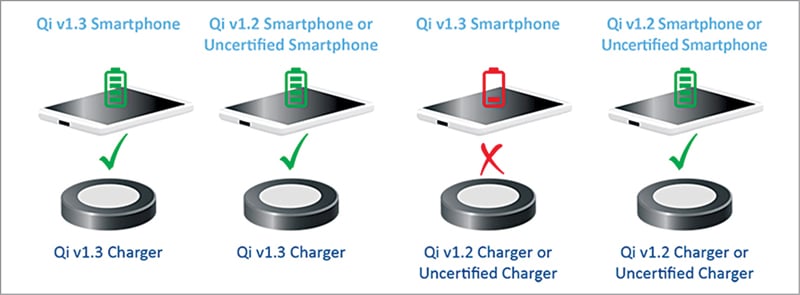
Modules such as ROHM BP3621, ROHM BP3622, and ML7660 from Lapis Technologies have integrated antenna boards.
More powerful processors
The wireless charging technology has been adopting new features to improve the stability, efficiency, and security of the system, thus requiring more powerful processors. The microprocessor also allows for easier tuning for certifications along with specification updates without PCBA change. Having a powerful processor helps in making functions extensible and enhances the capability to better customise the user interface (UI). The electromagnetic compatibility (EMC) performance depends on the microprocessor and its software operations.
Renesas’s P9261-3C-CRBv2 design includes a Renesas RH850 automotive microprocessor as a host controller, which enables the system to provide functional safety features that comply with automotive safety integrity level B (ASIL B). NXP MWCT1x23 is built upon the Arm Cortex-M4 core operating at up to 168MHz with DSP and a floating-point unit. STM STSAFE-V110 runs on an Arm SecurCore SC300TM 32-bit RISC core, which features a secured operating system that enhances the cryptographic security of the module. STM STWBC2 HP is a digital controller for wireless transmitters and runs on a 32-bit Arm Cortex M0 processor running at frequencies up to 64MHz.
Higher power transfer rate
Although the overall efficiency of portable devices, such as smartphones and smartwatches, is improving, the higher processing power and overall improvement in features mean that these devices are getting more power-intensive, thus requiring bigger batteries. To improve the battery charging speed, manufacturers have been trying to increase the power transfer rate by wireless charging.
STM STWLC98 is a Qi-compliant 70W inductive power receiver that can also act as a 15W wireless transmitter. The NXP MWCT1123 is a power transmitter controller module based on the WPC standard that can transmit power up to 65W.
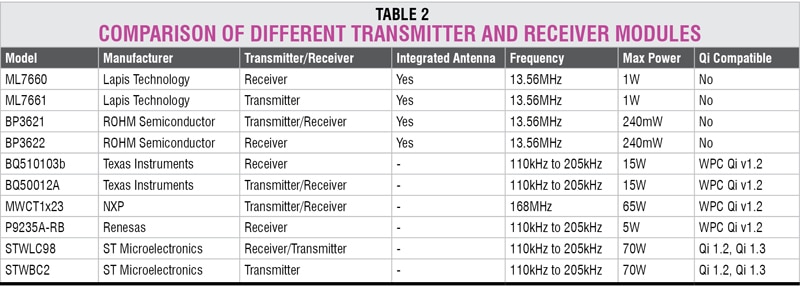 Better protection features
Better protection features
Newer wireless transmitters and receivers are featuring a lot of functionality and are capable of transferring higher power, which makes them susceptible to cause unwanted problems like overheating, transferring overvoltage, etc. Therefore, the latest modules come with various protection features to ensure the reliability of the device.
TI BQ51013B-Q1 and STM STWLC98 feature foreign object detection, overcurrent and overvoltage protection, thermal shutdown, and fault host control. Some modules, such as NXP’s MWCT1123, feature a memory protection unit whereas some devices, such as STM STSAFE-V110, provide cryptographical security.
More number of interfaces
With the inclusion of new features and powerful processors in the wireless charging modules it can be safely said that the new devices come with an increased number of interfaces.

For communication, the Lapis ML7660/7661, NXP MWCT1123, and STM STWBC2 use SPI/I2C master UART as a serial interface. The Renesas P9235A features five GPIOs while STM’s STWBC2 has eight GPIOs for connecting with external devices.
Smaller modules for smarter wearables
Electronic gadgets are becoming more powerful and wireless at the same time, be it your smartwatch, wireless earphones, or any other gadget. Moreover, the increase in penetration of IoT in our everyday lives demands compact wireless charging modules. Companies such as TI, ROHM, and Lapis are competing to create compact modules.
Lapis ML7660/ML7661 is said to be the smallest wireless receiver capable of delivering 1W power while ROHM BP3621 and BP3622 wireless charging modules come with an integrated antenna and feature a small form factor, thus reducing the size of product along with time and cost of development.
However, there are many more upcoming tends. Some of these are described below.
GaN replacing silicon FET
Adoption of GaN transistors is the next big thing in wireless, which will improve the range and power transmission rate. GaN can help charge at rates from 30W up to several kilowatts, which was difficult to achieve using the silicon based charger. GaN based chargers are enabling higher charge transfer rates and better efficiency at a lower cost compared to silicon based solutions. The GaN based solutions enable higher transmitter and receiver frequencies of 6.78MHz or 13.56MHz, which are ideal for resonant charging.
The main advantages of the adoption of GaN FET are:
- Higher efficiency
- Lower cost
- Reduction in weight and size of the system
- Lower surface heat loss
Long distance charging
RF charging is hailed as the future of wireless energy harvesting for low-power IoT devices. The future scope of RF wireless charging was discussed at CES 2022. This charging technology allows charging at long distances from the transmitter.
At CES 2022, Motorola demonstrated over-the-air wireless charging of four phones simultaneously from a single transmitter for distances as far as 122cm (4 feet). Xiaomi and Oppo demonstrated their RF charging prototypes. Samsung also revealed an RF charging enabled remote, which was also featured in Best of CES 2020.
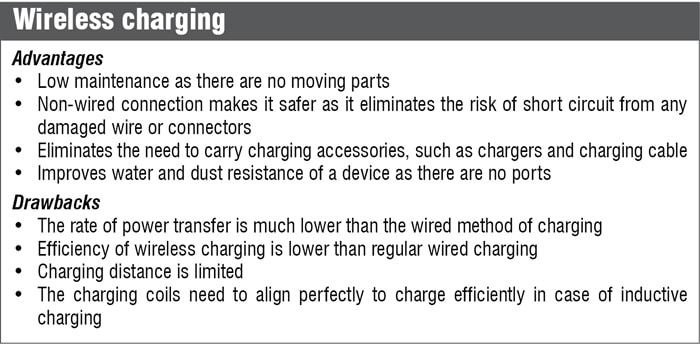 The RF frequency charging is capable of harnessing different frequencies from ambient energy. The technology is expected to mature in the coming years. RF charging is considered most suitable for smart wearable devices, IoT sensors, and applications in medical, military, sports, and many other industries.
The RF frequency charging is capable of harnessing different frequencies from ambient energy. The technology is expected to mature in the coming years. RF charging is considered most suitable for smart wearable devices, IoT sensors, and applications in medical, military, sports, and many other industries.
The future
Wireless charging technology will give engineers the freedom to make devices smaller and lighter by eliminating the energy storage devices, such as bulky batteries, in them. The improvement in processing capabilities of our handheld devices makes wireless charging a convenient or rather an essential technology.
Wireless charging is not limited to consumer electronics, it also has scope in automotive industry. Recently, in March 2022, Volvo announced that its XC-40 model will be able to receiving power greater than 40kW, which is much more than the existing AC charging and almost comparable to the DC fast charging.
RF charging is the key to making batteryless devices. Thus, wireless charging holds a lot of scope in commercial, medical, smart wearable, and military applications. Further development in this technology will help us get rid of chargers, cables, and power banks. We may soon witness the adoption of wireless charging solutions in the public space. RF charging will enable sensors placed at remotest of the location to work perfectly without human intervention.
The author, Sharad Bhowmick, works as a Technology Journalist at EFY. He is passionate about power electronics and energy storage technologies. He wants to help achieve the goal of a carbon neutral world.






